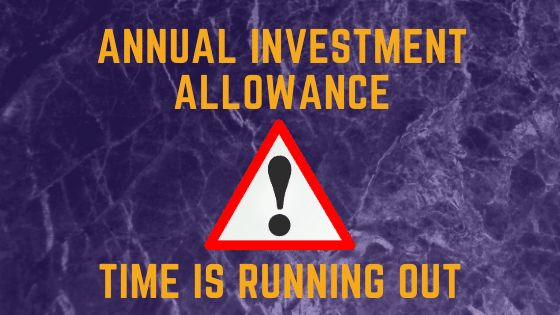The Annual Investment Allowance will revert to £200,000 on 1 January 2021, so you have just over six weeks to commit to any capital spend and take advantage of the temporary increase in Annual Investment Allowance of £1,000,000 which applies to any purchases made between 1 January 2019 and 31 December 2020.
The temporary Annual Investment Allowance increase was introduced to try to stimulate spending during the Brexit ‘transition’ period. Little did we know then, that not only would we not yet have any trade agreements signed, which really is a necessity for many business owners to have confidence to commit to major investments, but that we would have spent the last nine months in the middle of a global pandemic, the likes of which has never been seen before.
With this in mind, I wouldn’t be surprised if the temporary increase isn’t extended beyond 31 December 2020. After all, anything that can be done to support businesses and encourage investment and spending right now has got to be encouraged.
But for now, as things stand, you have a little over six weeks…
Annual Investment Allowance – what is it and why does it matter?
The Annual Investment Allowance (AIA) is a 100 per cent upfront allowance that applies to qualifying expenditure up to the specified annual limit.
The AIA is available for plant and machinery as well as any vehicle that is not a car. So for example AIA is allowed on vans, lorries and trucks bought at any time and motorbikes bought after 6 April 2009. It is also allowed on plant and machinery such as computer equipment, printers, office furniture, generators, engraving equipment and other machines or air conditioning and lighting systems.
For a full list of what you can and can’t claim on, please refer to the Gov.uk guidance here.
Where businesses spend more than the annual limit, any additional qualifying expenditure will attract relief under the normal capital allowances regime, where it will attract writing-down allowances at the main rate or special rate dependent on the specific item’s classification.
Why is now the time to be thinking about it?
The summer budget of 2015 set the annual investment allowance at £200,000 per annum from 1 January 2016. However after the Brexit referendum a measure was introduced to temporarily increase the AIA to £1,000,000 for purchases between 1 January 2019 and 31 December 2020.
The thinking behind this was to stimulate business investment in the economy by providing an increased incentive for businesses to invest in plant or machinery, through the uncertainty of the UK leaving the European Union.
This means that there is a short window of opportunity left to take advantage of this increased allowance.
My business year end is not the same as the calendar year – how do I work out what my actual Annual Investment Allowance is?
It is very important to use the correct addition date when calculating relief as AIA will be apportioned on a time basis.
Where a business has a chargeable period that spans 1 January 2019, the maximum allowance for that business’s transitional chargeable period comprises 2 parts:
- Based on the £200,000 cap for the portion of the period falling before 1 January 2019
- Based on the temporary £1,000,000 annual cap for the portion of the period falling on or after 1 January 2019
If you are planning any significant expenditure in the near future, it’s really important to consider the timing of your investment, especially as the final period of £1,000,000 ends on the 31st December 2020.
Businesses with accounting periods straddling this time will need to carefully consider when to make purchases prior to the annual investment allowance dropping back down to £200,000 from 1 January 2021.
How do I work out the appropriate dates?
For Capital Allowance purposes the addition date is normally the date on which the obligation to pay becomes unconditional, which is usually the delivery date.
If there is an extended credit period which exceeds 4 months, the date of purchase shifts to the due date of payment. Actual payment date is irrelevant.
Is this the same as First Year Allowance?
No, first year allowances are also referred to as ‘enhanced capital allowances’ and do not count towards your AIA limit. They tend to be limited to certain energy and water efficient equipment, and do now include some electric and hybrid cars.
If an asset purchased qualifies for First Year Allowances (FYA), this allowance is in addition to AIA and the cost will not form part of the AIA allowance.
In this instance it is preferable to use the FYA where available before eating into the AIA allowance.
Other points to consider:
- If the business closes, AIA cannot be claimed in the final period.
- AIA is not available for partnerships where one partner is a company or another partnership.
- If you sell the item after claiming AIA you may need to pay tax.
- If you do not want to claim the full cost, for example you have low profits, you can claim:
- writing down allowances instead
- part of the cost as AIA and part as writing down allowances
- It is also important to remember that the limits are shared between group companies, but that the companies are able to allocate the allowances as they wish between them to maximise relief for the higher spending group member.
Claiming your Annual Investment Allowance is particularly complicated at this time, so do ensure you take specialist advice if you are considering a large purchase. As always the IN Team will be happy to help and can be reached by all the usual channels, or via our contact us page on our website.







